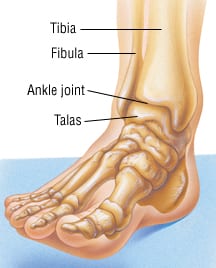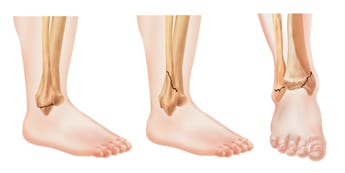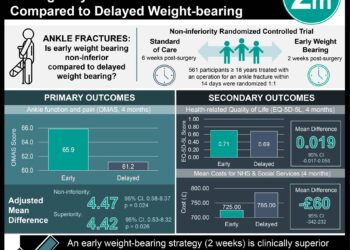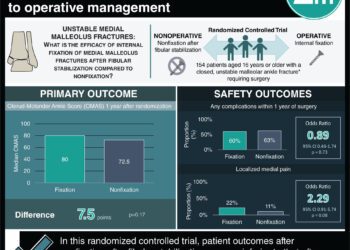Patient Basics: Ankle Fracture
Originally published by Harvard Health.
What Is It?
When a bone breaks or cracks, the injury is called a fracture. In the ankle, three different bones can be fractured:
- The tibia — This is the larger of the two bones in the lower leg. The tibia’s lower end flares out, forming a hard, bony knob, called the medial malleolus, which you can feel at the inside of your ankle.
- The fibula — This is the thinner of the two bones of the lower leg. Its lower end forms a hard, bony knob, called the lateral malleolus, which you can feel at the outside of your ankle.
- The talus — This is a wedge-shaped bone that is located deep inside the ankle, braced between the heel bone and the ends of the tibia and fibula. The talus supports the lower ends of the tibia and fibula, and it forms a solid base for the normal range of ankle movements.
Although there are many ways to fracture an ankle bone, the most common injuries involve a sharp twist of the ankle or a direct impact that fractures at least one of the bony knobs in the ankle.
Ankle fractures are common injuries among people of all ages, interests and lifestyles. People involved in a wide range of athletic activities, including ballet dancers, snowboarders, basketball players and skydivers, are at high risk of ankle fractures because of the physical demands placed on their ankles. Ankle fractures also occur during slips on icy pavement, falls from a high place, or direct impacts to the ankle during a car crash or motorcycle accident. High-impact ankle injuries are especially dangerous if the bone pokes through the skin and is exposed to the air. The open wound allows bacteria to contaminate the broken bone, and greatly increases the risk of infection.
Symptoms
If you have a fractured ankle, your symptoms probably will include:
- Pain, swelling, tenderness and bruising at your ankle joint
- Inability to move your ankle through its normal range of motion
- Inability to bear weight on your injured ankle — However, if you can bear weight on the ankle, don’t assume there is no fracture.
- In some cases, a “crack” or “snap” in the ankle at the time of injury
- In open fractures, severe ankle deformity, with portions of the fractured bone visible through broken skin
Diagnosis
After reviewing your symptoms, the doctor will want to know:
- How and when your injury happened
- Whether swelling and bruising developed immediately (often a sign of a more serious injury) or several hours later
- Whether you had difficulty putting weight on your ankle immediately after the injury happened
In addition, your doctor will review your medical history, especially any previous injuries to your ankle, foot or lower leg. If you have symptoms of an open fracture, the doctor also will want to know the approximate date of your last tetanus shot.
The doctor will examine your ankle, foot and lower leg. During this examination, the doctor will check for swelling, deformity, abrasions, bruising and soreness along the lower part of your tibia and fibula, especially at the medial malleolus and lateral malleolus (bony knobs). The doctor also will gently press and feel parts of your injured ankle to determine whether there are any points of extreme tenderness that can help to identify the site of a fracture. He or she also will compare range of motion of the injured ankle with the normal joint movement in your uninjured ankle. After a significant injury, your pulse, foot movements and skin sensation will be checked to see if there are signs of artery or nerve damage.
If the results of your physical examination suggest that that you have a fractured ankle, your doctor will order X-rays to confirm the diagnosis.
Expected Duration
If your fracture can be treated without surgery, you probably will wear a cast for about six to eight weeks. Once your cast is removed, you may need physical therapy before you can resume your normal activities. Total recovery time varies depending on the severity of your injury and the physical demands of your lifestyle.
If you need surgery to repair your fractured ankle, your recovery will take longer than an ankle fracture that could be treated without surgery.
Prevention
An athlete who has recovered from an ankle injury may find it helpful to use high-top shoes, an ankle brace or ankle taping to reduce the risk of further joint damage.
Treatment
If your ankle fracture involves only one malleolus, and the segments of broken bone lie very close together, your doctor usually can treat the injury by immobilizing your ankle and foot in a cast for six to eight weeks. After the cast is removed, your doctor will prescribe physical therapy to help restore the normal range of motion in your ankle joint.
If you have more extensive damage to your ankle, or the fragments of broken bone are separated far from one another, your doctor will perform surgery to repair your fractured ankle with special screws or wires. Injuries resulting in broken skin require antibiotics given intravenously (into a vein) to prevent infection.
When To Call A Professional
Call your doctor or go to an emergency room immediately if:
- You have injured your ankle and cannot walk on it
- Your injured ankle is very painful or tender
- Your injured ankle is obviously swollen, black and blue, or deformed
Also, check with your doctor if you have less severe symptoms that do not improve within three to four days.
Prognosis
If an ankle fracture is treated promptly and properly, the prognosis is good. Overall, about 80% of all sports-related ankle fractures heal without any long-term complications. However, as with any significant injury near a joint, arthritis may develop years later.
Additional Info
National Institute of Arthritis and Musculoskeletal and Skin Diseases
Information Clearinghouse
1 AMS Circle
Bethesda, MD 20892-3675
Phone: (301) 495-4484
Toll-Free: (877) 226-4267
Fax: (301) 718-6366
TTY: (301) 565-2966
http://www.niams.nih.gov/
National Rehabilitation Information Center (NARIC)
4200 Forbes Boulevard
Suite 202
Lanham, MD 20706
Phone: (301) 459-5900
http://www.naric.com/naric/
American Orthopedic Society for Sports Medicine
6300 North River Rd.
Suite 200
Rosemont, IL 60018
Phone: (847) 292-4900
Toll-Free: (877) 321-3500
Fax: (847) 292-4905
http://www.sportsmed.org/
National Athletic Trainers’ Association
2952 Stemmons Freeway
Dallas, TX 75247-6196
Phone: (214) 637-6282
Fax: (214) 637-2206
http://www.nata.org/





